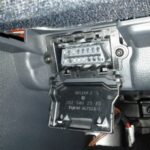The OBD2 to OBD1 adapter for GM vehicles allows access to diagnostic information on older models. This article explores its use for 1994-95 GM cars with a 16-pin OBD2-style connector but using the OBD1 protocol. We’ll discuss compatibility, functionality, and alternative options for various GM models.
Understanding the OBD2 to OBD1 Adapter for GM
GM vehicles from 1994 and 1995 often present a confusing scenario: a 16-pin OBD2 connector housing an OBD1 system. This requires a specific adapter to bridge the gap between modern diagnostic tools and these classic cars. The adapter utilizes the existing 16-pin connector, drawing power and ground from pins 16 and 5 respectively, with serial data transmitted through pin 9.
This setup allows for diagnostics and even instrument cluster programming on certain models like the 2004-2006 Pontiac GTO. Functionality includes adjusting shift light activation RPM, customizing the cluster logo, and modifying shutdown text. Experimentation with other newer GM cars and trucks with similar configurations might reveal further programming possibilities.
Compatibility and Considerations for GM OBD1
It’s crucial to verify the connector type before purchasing an adapter. While this specific adapter works with the 16-pin OBD2 style connector on certain 1994-95 GM vehicles (Camaros, Firebirds, Corvettes, LT1 equipped cars, and some Australian Holden and Commodore models), it’s not universally compatible.
Cars with a 12-pin OBD1 ALDL connector, common in most 1984-1995 GM models, require a different cable. For broader compatibility across all OBD1 GM vehicles, including those 1994 and 1995 models with the 12-pin connector, a bare pin cable offers a more versatile solution.
Choosing the Right Diagnostic Solution
For vehicles with a true OBD2 system (1996 and later), a standard OBD2 scan tool is necessary for powertrain sensor scanning and code reading. Using the wrong tool can lead to connection issues and inaccurate readings.
The OBD2 to OBD1 adapter specifically targets the unique situation of 1994-95 GM vehicles with the 16-pin connector and OBD1 system. If your vehicle falls outside of this specific category, ensure you select the appropriate diagnostic tool for your car’s system. Referencing GM’s documentation or consulting with a specialist can help confirm compatibility.
Finding the Right Adapter
Choosing the right adapter is crucial for successful diagnostics. If you need a solution for your 1994 or 1995 GM vehicle with the 16-pin OBD2 style connector, this specialized OBD2 to OBD1 adapter provides a convenient way to connect. However, always double-check your vehicle’s connector type to ensure compatibility and choose the solution that best fits your diagnostic needs.

